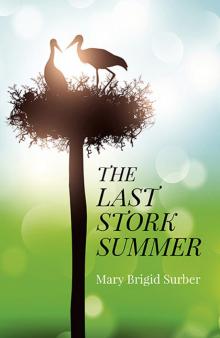- Home
- Surber, Mary Brigid
Last Stork Summer Page 12
Last Stork Summer Read online
Page 12
Forgotten Holocaust: The Poles under German Occupation 1939-1944 by Richard C. Lukas (Hippocrene Books, Inc., 1990). This book chronicles, with thorough documentation, Germany’s occupation and destruction of Poland’s culture and people.
In addition, some of the history behind the story was found online at these two sources:
The Jewish Virtual Library – an article titled “Stolen Children” by Gitta Sereny.
The Museum of Tolerance Online – an article titled “Non-Jewish Children in the Camps” by Sybil Milton.
Approximately 200,000 Polish children were taken from their homes between 1939 and 1945. Under the Nazi occupation, Poland was taken over, occupied and settled by German settlers causing forced resettlement of the original inhabitants. Poland was racially and geographically consolidated into Germany.
Eventually all Polish children between the ages of two and twelve were examined and segregated into two categories: “racially valuable or worthless,” as Himmler once wrote. Children found to be racially worthless were either sent home or, if old enough and capable, sent to Germany to work. Those with racial potential were taken to one of three centers in the Warthegau, where further tests were conducted.
Forgotten Holocaust, on page 25, cites Himmler: “I would consider it right if small children of Polish families who show especially good racial characteristics were apprehended and educated by us in special institutions and children’s homes which must not be too large.”
In December 1942, a camp for Polish children and youth known as Litzmannstadt was established in a separate area within the walls of the Lodz ghetto. The main gate to the camp was located on Przemyslowa Street; which is why it was often referred to as “The Camp on Przemyslowa Street.”
On November 28, 1942, the Main Security Office of the Reich explained that it would be a camp for adolescent Poles, those adolescents deemed to be criminals or uncared-for, “who, therefore, are a dangerous element both for the German children, and because of the fact that they could continue their criminal activity.”
The camp was made to look like an educational facility to rehabilitate juvenile offenders. In reality though, it was a concentration camp for children and youth up to the age of 16. The young inmates had numbers instead of names, wore gray prison clothes and clogs, and worked from morning to night. They were also subjected to routine beatings. The camp area was surrounded by a high fence made up of planks and patrolled by German sentries.
The camp prisoners primarily came from the areas incorporated into the Reich once they had conquered Poland. Some children were taken from orphanages; some were taken from parents who’d been arrested for their involvement in the resistance movement. Some were children who had been taken from their families for “Germinization” but had been unable to pass the exhaustive racial examinations.
By January 1945, an estimated 1,600 Polish children went through this camp. The exact number of inmates is difficult to establish because many of the records are missing. When the war was over, there were about 900 prisoners in the camp.
The children worked just as their peers did in the ghetto, on the other side of a high wall. The children stitched clothes, made straw shoes, mended knapsacks and straightened out needles. Many of them died of starvation, cold and emaciation, especially during the typhus epidemic that broke out in late 1942 and early 1943. Records document 136 deaths.
The Polish children in this camp were completely isolated from the outside world and had no contact with the people from the other side of the wall. A branch of this camp also operated on a private estate in Dzierzana, 15 kilometers from Lodz.
Today, only the old camp administrative building at 34 Przemyslowa St. remains. For many years after the war, people did not know about this camp for Polish children and youth. In May 1971, the Broken Heart Monument was unveiled in Szarych Szeregow Park, a somber reminder of the young victims. The monument, designed by Jadwiga Janus and Ludwik Mackiewicz, is located just outside the old camp area. The inscription reads, “They’ve taken your lives. Today we can offer you only memory.”
To that inscription I would add one thing: “Love leaves a memory no one can steal.”
Historical fiction that lives.
We publish fiction that captures the contrasts, the achievements, the optimism and the radicalism of ordinary and extraordinary times across the world.
We’re open to all time periods and we strive to go beyond the narrow, foggy slums of Victorian London. Where are the tales of the people of fifteenth century Australasia? The stories of eighth century India? The voices from Africa, Arabia, cities and forests, deserts and towns? Our books thrill, excite, delight and inspire.
The genres will be broad but clear. Whether we’re publishing romance, thrillers, crime, or something else entirely, the unifying themes are timescale and enthusiasm. These books will be a celebration of the chaotic power of the human spirit in difficult times. The reader, when they finish, will snap the book closed with a satisfied smile.

 Last Stork Summer
Last Stork Summer